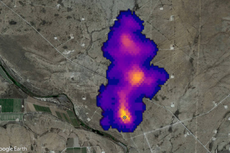Belgium-sized fires destroying the Arctic due to global warming
‘By the end of the century, large fires such as those in 2019 and 2020 will be frequent,’ experts warn
Global warming is driving an exponential increase in megafires across the Arctic, new research warns.
In 2020, fires destroyed an area almost as big as Belgium as fire rates in the Siberian Arctic exceeded those of the last four decades.
The number of fires was seven times higher than the average since 1982, according to the study.
Scientists attributed this dramatic increase to rising temperatures as the summer of 2020 was the warmest in the last 40 years.
Approximately 4.7 million hectares burned between 2019 and 2020, resulting in total emissions of 412.7 million tonnes of greenhouse gases.
The increase of fires has had multiple consequences.
The Arctic has large areas of permafrost, which is a permanently frozen layer of subsoil that accumulates large amounts of carbon. With the rise of fires, the permafrost has been damaged, causing a huge release of greenhouse gasses.
Fires also destroy the dynamic habitats and ecosystems that have been thriving for years.
Dr Adrià Descals, a scientist from the Spanish Council for Scientific Research (CSIC) and the Centre for Research on Ecology and Forestry Applications (CREAF), and co-author of the study, said: “In 2020 alone, 423 fires were detected in the Siberian Arctic, which burned around 3 million hectares, an area almost as big as the whole of Belgium, and caused the emission of 256 million tonnes of CO2 equivalent.”
Dr Josep Peñuelas, a scientist from CSIC and CREAF, and co- author of the study, added: “Temperatures are reaching a critical threshold where small increases above the summer average of 10C can exponentially increase the area burned and the associated emissions.”
Dr Descals said: “The 2020 average summer temperature – which was 11.35C – will be very common from the second half of the century on if the Arctic warming continues at the same rate.
“These temperature anomalies increase fire risk factors, so the conditions that were led to the 2019 and 2020 fires will be recurrent in the Arctic by the end of the century.”
Factors caused by higher temperatures such as drier weather conditions, longer summers, and more vegetation have shown a consistent trend over the past four decades and contribute to the rise in fires.
Dr Peñuelas explained: “Higher temperatures explain the earlier thaw, which in turn allows for greater vegetation growth and increases fuel availability.”
Dr Aleixandre Verger, a researcher at CSIC and CREAF, added: “The fact that there is more and earlier vegetation reduces the availability of water in the soil, and plants suffer greater water stress.
“Extreme heat waves, such as in 2020 in the Siberian Arctic, increase vulnerability to drought, as they can desiccate plants and reduce peat moisture, and therefore increase the intensity of fires and carbon emissions”.
One other key consequence of these rising temperatures is an increase in storms and lightning, which before now have been very rare in the Arctic.
Dr Descals said: “We detected fires above the 72nd parallel north, more than 600km north of the Arctic Circle, where fires are unusual and where winter ice was still visible at the time of burning.
“Many fires were detected with a few days of difference, so we hypothesise that increases in thunderstorms and lightning are the main cause of the fires, although further investigations would be required to demonstrate how much human activities may influence the fire season in this remote region.”
He added: “Climate warming therefore has a double effect on fire risk: it increases the susceptibility of vegetation and peatlands to fire and, on the other hand, it increases the number of ignitions caused by thunderstorms.
“The areas burned in 2019 and 2020 could be exceptional events, but recent temperature trends and projected scenarios indicate that, by the end of the century, large fires such as those in 2019 and 2020 will be frequent if temperatures continue to increase at the current rate.”
The study was published in the journal Science.
SWNS
Join our commenting forum
Join thought-provoking conversations, follow other Independent readers and see their replies
Comments


Bookmark popover
Removed from bookmarks